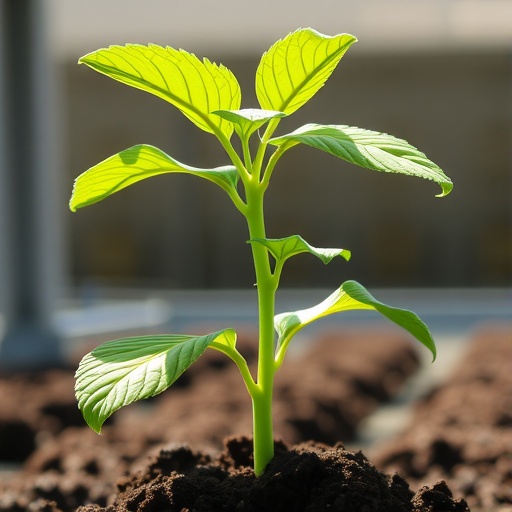In a groundbreaking advance that promises to revolutionize agricultural biotechnology, a team of plant biologists has devised a novel technique that dramatically accelerates the creation of transgenic and gene-edited plants. Published on November 6 in the esteemed journal Molecular Plant, this innovative method harnesses the inherent regenerative capabilities of plants to bypass the traditionally protracted and costly tissue culture processes that have long impeded progress in crop genetic engineering.
The conventional approach to generating transgenic plants involves editing the DNA of isolated plant cells and then coaxing these cells to develop into whole plants through tissue culture. This intricate procedure, varying by crop species, can range from several months to nearly a year. For instance, relatively regenerable plants like tomatoes require a minimum of four months, whereas species such as cotton can extend the process close to twelve months. More recalcitrant species, including beans and peppers, often pose insurmountable challenges under standard tissue culture protocols.
The team’s breakthrough capitalizes on the natural wound-healing and regenerative response of plants, which, upon injury, trigger a complex molecular cascade designed to restore lost tissues. Central to this process is a transcription factor known as WIND1, which initiates a sequence of protein activations orchestrating cellular dedifferentiation and shoot formation. By exploiting this intrinsic biological mechanism, researchers have succeeded in dramatically expediting the regeneration phase critical for the production of genetically modified plants.
Technique-wise, the innovation involved engineering Agrobacterium, a bacterial genus naturally capable of transferring DNA into plant cells. By embedding genetic constructs encoding the key regulators of plant regeneration—WIND1, ESR1, and additional shoot-promoting genes—into Agrobacterium alongside a gene conferring red pigmentation as a visual marker, the researchers created a robust system to induce regeneration while simultaneously delivering transgenic material. Plants were pruned to expose wound sites, which were then inoculated with the modified bacteria, setting the stage for new shoot development directly at the wound interface.
Senior author Gunvant Patil from Texas Tech University described the process as a molecular relay, with WIND1 activating ESR1, which in turn triggers downstream proteins pivotal for shoot differentiation. This cascade effectively reprograms plant cells in situ, obviating the need for isolated tissue culture and accelerating the emergence of genetically transformed shoots.
Initial trials in tobacco, a model species amenable to regeneration, demonstrated the method’s efficiency, with approximately 35% of regenerated shoots exhibiting transgenic traits and red pigmentation. Tomato plants, less facile in tissue culture regeneration, yielded transformed shoots at a success rate of 21%, showcasing the technique’s versatility across species with differing regenerative capacities.
While the approach initially faltered in soybeans—traditionally one of the most challenging crops to regenerate—the team refined their method. Instead of treating pruned shoots, they exposed germinating soybean seeds to the engineered Agrobacterium. Following a brief 3.5-week incubation in tissue culture conditions before transfer to soil, transgenic shoots were obtained with an encouraging success rate of 28%. This represents a seismic reduction from the conventional 3-4 month tissue culture period imposed on soybean transformation workflows.
Coauthor Luis Herrera-Estrella emphasized the method’s potential to unlock genetic transformation in otherwise recalcitrant species by mimicking more natural regenerative processes and significantly compressing the timeline from genetic manipulation to mature plants. This breakthrough opens doors not only for soybeans but also for other economically vital yet difficult-to-transform crops such as chickpeas and common beans.
Beyond accelerating timelines, the strategy holds promise for increasing scalability and reducing the resource burdens associated with plant genetic engineering. By simplifying protocols and leveraging the plant’s own molecular toolkit for regeneration, researchers anticipate far greater accessibility to advanced genetic modifications, fostering rapid development of improved crop varieties resilient to environmental stress and disease.
The underlying molecular biology of the technique represents a sophisticated synthesis of plant developmental biology and genetic engineering. The cascade triggered by WIND1 mimics the natural wound response at the transcriptional level, recruiting a suite of gene products that reprogram cells toward meristematic fate—cells capable of forming new shoots and ultimately whole plants. The gene ESR1 functions as a critical intermediary, bridging early response factors with later differentiation stages, orchestrating the complex choreography of plant tissue regeneration.
This research stands at the nexus of plant physiology, molecular biology, and bioengineering, heralding a paradigm shift in how biotechnologists approach crop improvement. By embracing the plant’s endogenous regenerative machinery and combining it with precision gene delivery, the method holds promise to democratize access to gene editing in agriculture and accelerate the pace of breeding programs aiming to secure food security in the face of global challenges.
Funded by the State of Texas’ Governor’s University Research program and USDA-NIFA, this work exemplifies how strategic investment in fundamental and applied plant science can yield transformative technologies. With ongoing efforts to optimize and extend this method to a broader array of plant species, the future of agriculture may soon benefit from faster, more efficient, and more naturally inspired approaches to plant genetic modification.
Subject of Research: Plant regeneration and genetic engineering in crop species
Article Title: A synthetic transcription cascade enables direct in planta shoot regeneration for transgenesis and gene editing in multiple plants
News Publication Date: November 6, 2025
Web References: http://dx.doi.org/10.1016/j.molp.2025.09.017
Keywords: Genetically modified crops, Crop science, Regeneration, Horticulture, Gene editing
Tags: accelerating gene editing in plantsbiotechnology advancements in cropscrop genetic engineering breakthroughsefficient transgenic plant creationenhancing plant regeneration processesinnovative agricultural techniquesmolecular cascades in plant healingnatural regeneration in agricultureovercoming challenges in plant tissue culturereducing tissue culture time for plantstransgenic plant developmentWIND1 transcription factor role





